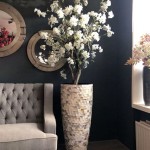Home Decor Canvas Art: A Comprehensive Guide
Canvas art has emerged as a prominent element in contemporary interior design, offering a versatile and accessible means of adding visual interest and personality to residential spaces. Its appeal stems from a combination of factors, including its affordability, diverse range of styles, and relatively simple installation process. Unlike other forms of artwork, canvas prints provide a tangible texture and visual depth that can significantly enhance the aesthetic appeal of a room.
This article provides a comprehensive overview of home decor canvas art, exploring its various forms, styles, selection criteria, and placement considerations. The goal is to equip individuals with the knowledge necessary to make informed decisions when incorporating canvas art into their home decor schemes.
Understanding the Medium: Canvas and Printing Techniques
The foundation of canvas art lies in the canvas itself. Traditionally, canvas was made from linen or cotton, stretched tightly over a wooden frame. While linen offers superior durability and a finer weave, cotton is a more cost-effective alternative. Modern canvases often utilize a blend of these materials to balance cost and performance.
The printing process is equally crucial. Several techniques are employed to transfer images onto canvas, each with its own set of characteristics. Giclee printing, a high-resolution inkjet printing process, is widely favored for its ability to reproduce vibrant colors and fine details. This method utilizes archival inks, which are resistant to fading and degradation, ensuring the longevity of the artwork. Other printing methods, such as dye-sublimation, may be used, but they generally offer lower print quality and durability compared to giclee prints.
Beyond the printing process, the finishing touches contribute to the overall aesthetic. A protective coating, often in the form of a varnish or laminate, is applied to shield the canvas from UV radiation, moisture, and physical damage. This coating also enhances the colors and adds a subtle sheen to the artwork. The edges of the canvas can be either wrapped around the frame (gallery wrap) or left plain. A gallery wrap provides a clean, contemporary look, while plain edges can be left exposed or framed for a more traditional appearance.
Navigating Styles and Subjects: A Diverse Landscape of Options
The spectrum of styles and subjects available in canvas art is virtually limitless, catering to a wide range of tastes and preferences. Abstract art, characterized by its non-representational forms and emphasis on color and texture, is a popular choice for adding a modern and sophisticated touch to a space. Geometric patterns, with their precise lines and shapes, offer a sense of order and visual interest.
For those who prefer representational art, landscape paintings provide a sense of tranquility and connection to nature. These can range from realistic depictions of specific locations to more stylized and abstract interpretations of natural scenes. Similarly, floral prints bring a touch of vibrancy and elegance to a room. The style can vary from botanical illustrations to impressionistic renderings of bouquets.
Portraiture, whether depicting historical figures, celebrities, or personal subjects, adds a personal and intimate touch to a decor scheme. Photographic prints, capturing moments in time or showcasing striking compositions, offer a contemporary and often documentary element. Pop art, with its bold colors and iconic imagery, adds a playful and retro vibe to the space.
The choice of style and subject matter should align with the overall aesthetic of the room and the individual's personal preferences. Consider the existing color palette, furniture styles, and overall ambiance when selecting canvas art. A cohesive and well-coordinated approach will result in a visually harmonious and pleasing environment.
Choosing the Right Canvas Art: Key Considerations for Selection
Selecting the right canvas art involves careful consideration of several factors, including size, color, resolution, and framing options. The size of the artwork should be proportionate to the wall space and the surrounding furniture. A small canvas in a large room may appear insignificant, while an oversized canvas in a small room can feel overwhelming.
The color palette of the artwork should complement the existing colors in the room. Consider the dominant colors of the walls, furniture, and accessories when choosing canvas art. A harmonious color scheme will create a sense of balance and visual unity. Conversely, a strategically placed canvas with contrasting colors can serve as a focal point and add visual interest.
The resolution of the print is crucial for ensuring a sharp and detailed image. Low-resolution prints can appear blurry and pixelated, detracting from the overall aesthetic. Look for prints with a high DPI (dots per inch) to ensure optimal image quality. The printing technology used (e.g., giclee) also impacts the final resolution and detail.
Framing options can significantly alter the appearance of canvas art. A simple gallery wrap provides a clean, contemporary look, while a traditional frame adds a touch of elegance and formality. The choice of frame should complement the style of the artwork and the overall decor of the room. Consider the material, color, and style of the frame to ensure a cohesive and visually appealing result.
Beyond the technical aspects, consider the emotional impact of the artwork. Does it evoke a feeling of calm, excitement, or contemplation? The artwork should resonate with the individual and contribute to the overall atmosphere of the space. Personal preference is a key factor in selecting canvas art that will be enjoyed for years to come.
Placement and Arrangement: Optimizing Visual Impact
The placement and arrangement of canvas art can significantly impact its visual impact. Consider the focal points of the room and the existing furniture layout when determining where to hang the artwork. A canvas placed above a sofa or fireplace often serves as a focal point, drawing the eye and anchoring the space.
The height at which the canvas is hung is also important. The general rule of thumb is to hang the artwork so that the center of the canvas is at eye level. However, this may need to be adjusted depending on the height of the ceiling and the size of the room. Consider the viewing distance when determining the optimal hanging height.
When hanging multiple canvases, consider the overall arrangement. A symmetrical arrangement, with canvases of the same size and shape hung in a grid pattern, creates a sense of order and formality. An asymmetrical arrangement, with canvases of varying sizes and shapes hung in a more organic pattern, adds visual interest and dynamism.
The spacing between canvases is also crucial. Too much space can make the arrangement feel disjointed, while too little space can make it feel cluttered. A general guideline is to leave approximately 2-5 inches of space between canvases, depending on their size and the overall aesthetic.
Consider the lighting when placing canvas art. Avoid placing canvases in direct sunlight, as this can cause fading and damage over time. Use artificial lighting to highlight the artwork and enhance its visual impact. Track lighting or spotlights can be used to create dramatic effects, while soft, ambient lighting can create a more subtle and inviting atmosphere.
Furthermore, think about the background behind the canvas. A plain wall will allow the artwork to stand out, while a patterned wall may compete for attention. Consider the color and texture of the wall when choosing canvas art and determining its placement.
Maintaining and Protecting Canvas Art: Ensuring Longevity
Proper maintenance is essential for preserving the beauty and longevity of canvas art. Regular dusting with a soft, dry cloth is recommended to remove dust and debris. Avoid using harsh chemicals or abrasive cleaners, as these can damage the canvas and the print. A slightly damp cloth can be used to remove stubborn stains, but be sure to dry the canvas immediately afterwards.
Protecting canvas art from direct sunlight is crucial to prevent fading and discoloration. Hang canvases away from windows or use curtains or blinds to filter the sunlight. UV-protective coatings can also be applied to the canvas to provide additional protection.
Avoid exposing canvas art to excessive moisture or humidity, as this can cause the canvas to warp or mold to grow. Keep canvases away from bathrooms or kitchens where humidity levels are high. If storing canvas art, choose a cool, dry place.
Handle canvas art with care to avoid scratches, dents, or tears. When moving canvases, use gloves to protect the surface from fingerprints and oils. Wrap the canvases in protective material, such as bubble wrap or acid-free paper, to prevent damage during transit.
By following these simple maintenance and protection tips, individuals can ensure that their canvas art remains a beautiful and cherished part of their home decor for many years to come. Investing in quality canvas art and taking proper care of it is a worthwhile endeavor that will enhance the aesthetic appeal and value of any living space.

Floral Decorative Wall Art Canvas Painting Print Decor Picture Home De Street

Jlong Forest Canvas Wall Art Living Room Decor Large Nature Unframed Pictures Artwork Contemporary Modern Landscape Foggy Sunshine For Kitchen Office Home Decoration Com

Decor Art Wall Ideas Prints Canvas Bedroom W In 2025 Living Room Multi Painting

Flowers Painting Canvas Prints Wall Decor Art For Living Room Bed Street

Original Abstract Painting Cityscape Wall Art Home Decor Ag130 By Kal Soom Saatchi

Abstract Golden Tin Foil Shiny Wall Art Canvas Painting Home Decor Hotel Office Modern Simple Luxury Decoration Framed Picture China Print And Printing Made In Com

Wonderful Love Romantic Couple Home Art Interesting Canvas On Wall Picture Living Room Decoration Painting Joom

Extra Large Wall Art Street Canvas Print Living Room

Painting Ideas 36 Easy Diy Canvas Paintings To Make Art At Home Decor Artistic

Black And Golden Flower Wall Art Canvas Painting For Living Room Decor Modern Abstract Design No Frame Required Temu
Related Posts







